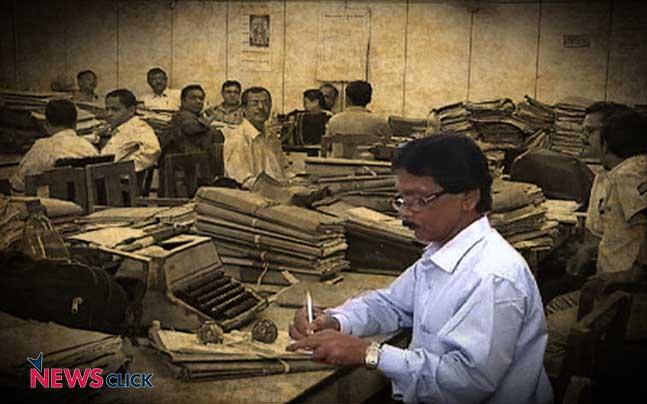Government Employees Do Not Work, is a Myth that Should be Broken Soon

Newsclick Image by Sumit Kumar
‘Work more’, seems to be the mantra of governance of the new Chief Minister of the state of Himachal Pradesh. While addressing the five unions of the secretariat employees in Shimla, he made this clarion call. The employees should work overtime to deliver goods to the people was his appeal. It sounds good and encouraging.
This also has another meaning. That, the employees do not work and in fact, once they get the government job they become lethargic and callous and take things for granted. After all, they will continue to get the salary even if they do not perform. Is this true? Apparently not. The performance of the government undoubtedly is linked to the pace in which delivery is done. But the stark reality of the incapacity of the government structure to perform should not go unnoticed. In the Himachal Pradesh state secretariat, there are near 3,000 employees and 1,000 vacancies in different categories of hierarchies. Similarly, in the state, there is more than 40% less staff than what is required to perform in different departments of the state. For example, in the state electricity board, the requirement is more than 43,000 employees whereas they are providing services to the state with just 23,000 workmen. So, do the employees not work or work overtime?
Let us take the example of Himachal Pradesh state secretariat once again. Near 3,000 employees bear a load of over 4,000, as there exists a vacancy of more than 1,000. A simple matrix of calculating their time, work and the money they are paid will describe how much more each employee is forced to labour. To deliver the services they perform more than 500%, which is incredibly high. Let us consider that 4,000 employees would have worked for eight hours a day, thus building in a labour of 32,000 hours in a day. Now the same work of 32,000 hours is done by just 3,000 employees thereby meaning that they (the employees) work nearly 10.66 hours daily, hence working overtime by almost 2.66 hours per employee.
Interestingly, if we bring in another matrix of adding the work done in the form of salary, paid then the extra work done is phenomenally high. Let us consider the same example once again. The 3,000 employees in the secretariat have a group of 500 who are on contract basis. Let us consider that the work of 32,000 hours per day was to be performed by disbursing an average salary of Rs 60,000 per month considering the salary disbursed to a regular employee ( from group IV to the highest rank). But to the 500 employees on a contract basis, the salary disbursed is just in between 8 to 10 thousand rupees. Let’s keep the average to Rs 9,000. This leads to an astonishing figure altogether. If for 8 hours of work in a day an employee (regular) gets Rs 2,000 then the 500 on contract basis gets just 300 rupees. It means that the regular employee is getting Rs 250 per hour work whereas the contract workmen are getting just Rs 300 for 8 hours. It gives an astonishing figure of the contract employee working almost 53.33 hours/daily, meaning almost 500% more than what is required.
Hence, that the government employees do not work, is a myth that must be broken as soon as possible. It is the structure in which the policies are framed that gives not much credence to performance. Interestingly, in the secretariat, the contract employees are discharging the duties of even senior assistants, whereas they are supposed to initially, work in the diary despatch section.
The perspective of overload with work must not miss the Chief Minister. Even the 2017 budget categorically mentioned about the outsourcing policy and its intention to get rid of it. However, this has just remained on paper. The reverse continues to be in practice. The new government must understand the reality and recruit employees on regular basis only. The policy of outsourcing and contractualisation must go.
The policy of outsourcing and contract employment happens to be the interesting feature of modern-day governance borrowed from the great Margaret Thatcher from England. Outsource more and you will have better governance. Whereas history has proven it wrong. There are studies from not just in India, but from England, from where this neo-liberal model of governance got copied. These studies have shown that the state (i.e. the nation-state) ends up paying more to the outsource contract system than employing them regularly and directly. Large-scale nepotism, nexus and cronyism were witnessed while awarding a contract.
Quite obviously, the important reasons for such a policy perspective were, a) to cut the government expenditure (spending more was considered an anathema for finance capital led developmental model), and b) the intent of the state was to diminish the role of organised trade union movement. To cut their sleeves by reducing their bargaining power. After almost 3 decades the crisis has worsened. it has not improved the situation globally. The World Inequality lab (WIL) is a large pointer towards it and must not go unreckoned with. Even the Chief Minister must ponder over it.
Get the latest reports & analysis with people's perspective on Protests, movements & deep analytical videos, discussions of the current affairs in your Telegram app. Subscribe to NewsClick's Telegram channel & get Real-Time updates on stories, as they get published on our website.
























